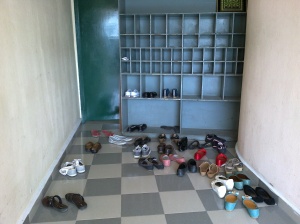A Shoe-rican started my obsession
I studied Industrial Design in Malaysia, during my fourth semester I was asked to design a piece of furniture, I chose a shoe rack since it had a different cultural aspect than where I came from, Egypt. Every country has its own shoe culture. My design process started as a quest to find an innovative concept for shoe cabinets that fit the Malaysian culture, in which shoes are not allowed inside houses, but have to be left outdoors.
I started my research by going to dorm halls and prayer rooms and observing how Malaysians place their shoes. One major observation was a repetitive outdoor scene – of Muslim prayer rooms and dorm halls – flooded with shoes which surrounded a big empty shoe cabinet. This left people fishing for their shoes when a room was well occupied, spotting one shoe here and one shoe there. Though Malaysia can’t take full credit for this, the sight sparked identical scenes in other countries i lived in or visited, like Egypt, Kuwait, and Hong Kong.
This shoe-rican is not a manifestation of a poor cabinet or shoe rack design, but rather of a bad behaviour. Humans have the tendency to be lazy whenever an opportunity presents itself, even one that involves a 10 second activity of picking up ones shoes and placing them in an open cabinet.
This got me thinking, instead of pointing a finger and telling people, you are bad, please change your behaviour and place your shoes inside (and how ineffective this is), can we design a shoe storage system that motivates people to use it?
And that’s when i started my research about Design and Behaviour Change.



I love that. Waiting for other posts. Very enjoyable. Would love to see photos also in the following posts.
What a great place to start!
Pingback: Ankaboot | Shoe Storage System | Selouk